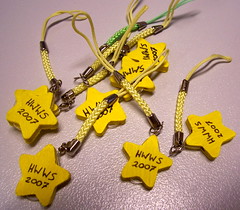"Years of experience with classroom teaching and more relatively recent research on the stimulation of brain activity indicate a coordinated connection between the eyes, the mind and the body, principally the hands. The experience of sensation related to imagination and thought processes can immediately heighten the experience of learning."In this special academic series post, Katy Cox, our CTJ educational consultant and former General Academic Coordinator, with years of classroom observation experience, tells us what a lead-in is, its importance to learning and practical ideas for the EFL/ESL classroom.
Unit: Healthy Food
Lead-in
props: two unmarked, closed paper bags, one with a hamburger, the other
with fruit that emits a citric or other fruity odor.
Prodecure:
after sts enter the classroom, they are invited to smell both bags – without
seeing the contents – and say which bag they prefer, and why. The teacher
announces that the bag most preferred will be given to a student at the end of
the class. The lesson then proceeds with visuals and activities related to the
unit topic. Bags are “raffled” randomly to “winners” at the end of the hour.
Unit: Travel Problems
Lead-in
props: passport, money belt, foreign coins or bills, vaccination form,
common medication ( Advil, motion sickness medicine, anti-acid tablets, etc),
health insurance card, etc. Each student receives an item and discusses with a
partner what importance that item might have on a trip – i.e. you are going to
take a trip; how would this item be useful to you? Then go to the second phase:
You are in the middle of your trip, and suddenly you don’t have this
item; what problems could arise because of this?
Lesson then
proceeds with book visuals and related exercises.
Unit – Good Luck Charms
 Lead-in
props: rabbit’s foot, good luck coin, etc; items from various
cultures representing talismans which either attract good luck or ward off
evil. Students discuss symbolic significance of each item and which aspects of
each one might be positive or protective ( i.e. rabbit: agile, fast, prolific
in propagation, clever at environmental blending, etc.). The teacher can
conduct an auction of the items to see which ones obtain the highest and lowest
bids.
Lead-in
props: rabbit’s foot, good luck coin, etc; items from various
cultures representing talismans which either attract good luck or ward off
evil. Students discuss symbolic significance of each item and which aspects of
each one might be positive or protective ( i.e. rabbit: agile, fast, prolific
in propagation, clever at environmental blending, etc.). The teacher can
conduct an auction of the items to see which ones obtain the highest and lowest
bids.
Lesson then
proceeds with visuals and related exercises.
Unit - Sports and Sports equipment
Lead-in
props: blind-fold strips and various kinds of balls (tennis, golf,
squash, baseball, etc). Half of the class or groups of three or four blindfold
an equal number of students; the teacher gives two or three balls to the
blindfolded sts, who pass them among each other, feeling how they are made and
of what material. The “seeing” students ask questions about the balls in play.
Then the process is reversed, after the first group of balls is identified, and
the other students are blindfolded and given a different set of balls. Once all
the balls have been identified, the sports which have been mentioned during the
“discovery” phase are put into columns on the board in accordance with book
indications; this serves as scaffolding for the opening unit page.


Hey Katy!
ReplyDeleteI used one of your suggestions and had a different group in front of me. Thanks for helping me connect with my students and have some fun! Thanks!
Dear Katy,
ReplyDeleteThank you for sharing these great lead-in activities. I'll try to use them in my groups next semester!
This comment has been removed by the author.
ReplyDeleteIt was a pleasure thinking about those lead-in activities.
ReplyDeleteGreat tips, Katy!
ReplyDeleteGоοd post. I am experiencіng many of thesе іssues
ReplyDeleteaѕ wеll..
Take a look at my webpage ; http://thinkstr.com
Thanks for sharing these inspiring lead-in activities. You are GREAT Katy!!
ReplyDeleteKaty has wonderful ideas for lead-in activities!!
ReplyDeleteKaty has wonderful ideas for lead-in activities!!
ReplyDeleteDear Katy, you've presented some great lead-in activities - thank you so much! I also believe that a good lead-in activity is vital in teaching.
ReplyDeleteSome of my ideas that worked like a charm include:
- a word association game in ppt (I have made two so far - you can find them on http://www.Busyteacher.org). By solving them students reveal what that particular lesson is about. They are fun,they develop students' deduction skills, they make them think in English at the very beginning of the lesson and keep them engaged.
- before introducing the useful phrases regarding eating out in a restaurant I play a video of Mr Bean in a French restaurant. They have a good laugh. Before moving on I say: "Well, you certainly don't want to find yourselves in a similar situation, so let's learn how to make a conversation in a restaurant." (Naturally,the food vocabulary has been covered in previous lessons.)
Thank you once again,
Gordana